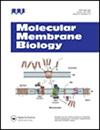Foreword for EDICT special edition, volume 2.
Q3 Biochemistry, Genetics and Molecular Biology
Molecular Membrane Biology
Pub Date : 2013-03-01
Epub Date: 2013-01-23
DOI:10.3109/09687688.2013.761918
引用次数: 0
Abstract
A central aim of the EDICT consortium was to obtain high resolution structures of a range of integral membrane proteins as a route to structure-aided drug design. The first issue of our special EDICT edition described efforts to express and isolate a wide range of membrane proteins in a number of different expression systems together with selected structureactivity studies. In this second issue we present further structure-activity studies, especially those detailing how structural information can be translated into platforms for the discovery of novel drugs. When no experimental structures are available, researchers depend upon homology models for their studies. Vaziri et al describe the validation of one such model of a major facilitator superfamily (MFS) transporter, using cysteine mutagenesis. In contrast, Patching et al utilized solid state NMR and sample deuteration to explore the low affinity binding site of the E. coli MFS transporter, GalP, demonstrating the usefulness of this technique for investigation of binding site dynamics. Gul et al explored the osmoregulatory properties of the ProUABC transporter, comprised of ProX, ProY and ProW, from E. coli following isolation and reconstitution into proteoliposomes. The findings reveal novel insights into the regulation of this interesting protein complex. Monne et al review the mutagenic data currently available as a means of shedding light on substrate specificity of mitochondrial carriers. This is complementedby the functional characterization of the human mitochondrial ADP/ATP carrier AAC1 described by Mifsud et al. Wohri et al have used isothermal calorimetry to investigate the thermodynamic changes in the pentameric glycine receptor upon ligand binding. In the latter part of the project, members of the EDICT consortium made significant progress in the identification and characterization of novel drug molecules, for a number of different membrane protein targets. Simmons et al used a structurebased virtual high-throughput screening (vHTS) technique initially developed for soluble proteins to identify inhibitors of LeuT and achieved a very impressive hit rate of 45%. Paulsen et al built on earlier extensive structural analysis to confirm the importance of the two C-terminal residues of the Na, K-ATPase in sodium binding. They also describe a combined computer docking and experimental approach to the preliminary characterization of dipeptides with potential to act as novel Na, K-ATPase inhibitors. Jurkowski et al describe a computational approach to the identification of key regions of the galanin receptors with roles in ligand interaction. Finally, Infed et al describe an approach involving modification of a known small molecule to generate novel inhibitors of multi-drug resistance transporters. Taken together, 19 manuscripts published in two special issues of Molecular Membrane Biology provide an overview of almost all of the research expertise required to take a protein from gene to early stage drug discovery. The results of the EDICT consortium have significantly moved the field of membrane protein drug discovery forward and have provided the basis for a range of different studies on these vitally important molecules.前言为诏书特别版,卷2。
本文章由计算机程序翻译,如有差异,请以英文原文为准。
求助全文
约1分钟内获得全文
求助全文
来源期刊

Molecular Membrane Biology
生物-生化与分子生物学
CiteScore
4.80
自引率
0.00%
发文量
0
审稿时长
>12 weeks
期刊介绍:
Cessation.
Molecular Membrane Biology provides a forum for high quality research that serves to advance knowledge in molecular aspects of biological membrane structure and function. The journal welcomes submissions of original research papers and reviews in the following areas:
• Membrane receptors and signalling
• Membrane transporters, pores and channels
• Synthesis and structure of membrane proteins
• Membrane translocation and targeting
• Lipid organisation and asymmetry
• Model membranes
• Membrane trafficking
• Cytoskeletal and extracellular membrane interactions
• Cell adhesion and intercellular interactions
• Molecular dynamics and molecular modelling of membranes.
• Antimicrobial peptides.
 求助内容:
求助内容: 应助结果提醒方式:
应助结果提醒方式:


